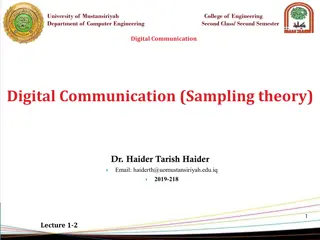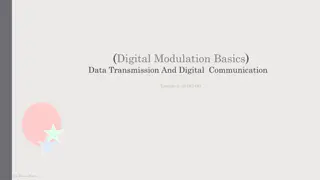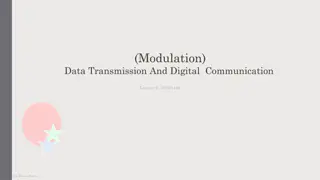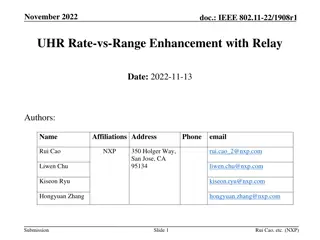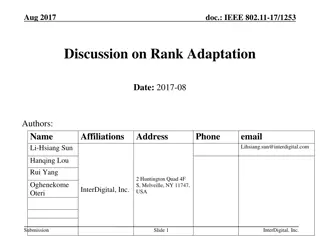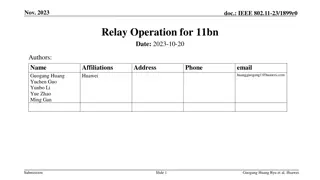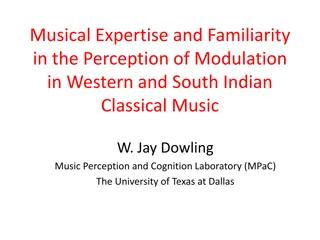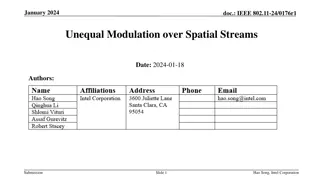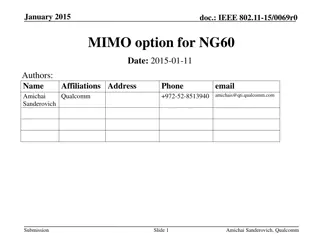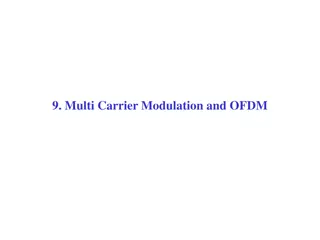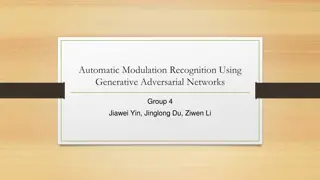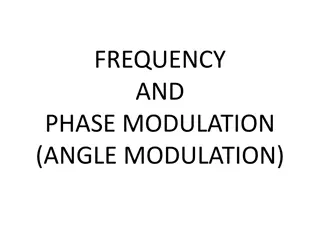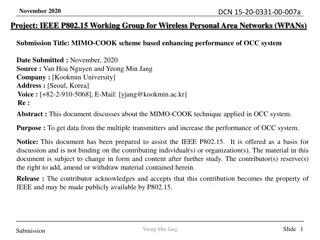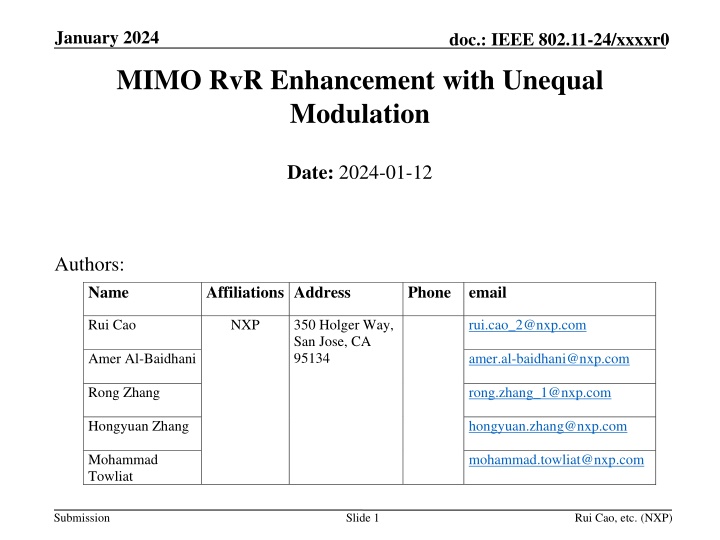
MIMO RvR Enhancement with Unequal Modulation - A Deep Dive into UHR Technologies
Delve into the world of IEEE 802.11-24/xxxxr0 as NXP experts explore Rate-vs-Range enhancement through Unequal Modulation for UHR MIMO systems. Learn about the impact of fading channels, unequal modulation design changes, and potential reliability enhancement technologies. Discover the nuances of spatial streams, channel statistics, and the evolution of modulation techniques for higher throughput in challenging wireless environments.
Download Presentation

Please find below an Image/Link to download the presentation.
The content on the website is provided AS IS for your information and personal use only. It may not be sold, licensed, or shared on other websites without obtaining consent from the author. If you encounter any issues during the download, it is possible that the publisher has removed the file from their server.
You are allowed to download the files provided on this website for personal or commercial use, subject to the condition that they are used lawfully. All files are the property of their respective owners.
The content on the website is provided AS IS for your information and personal use only. It may not be sold, licensed, or shared on other websites without obtaining consent from the author.
E N D
Presentation Transcript
January 2024 doc.: IEEE 802.11-24/xxxxr0 MIMO RvR Enhancement with Unequal Modulation Date: 2024-01-12 Authors: Name Affiliations Address Phone email NXP Rui Cao 350 Holger Way, San Jose, CA 95134 rui.cao_2@nxp.com Amer Al-Baidhani amer.al-baidhani@nxp.com rong.zhang_1@nxp.com Rong Zhang Hongyuan Zhang hongyuan.zhang@nxp.com Mohammad Towliat mohammad.towliat@nxp.com Submission Slide 1 Rui Cao, etc. (NXP)
January 2024 doc.: IEEE 802.11-24/xxxxr0 Introduction Rate-vs-Range (RvR) enhancement is an important objective for UHR In MIMO fading channels, equal modulation across spatial streams is sub-optimal, especially for ill- conditioned channels. In this presentation, we discuss about different technologies for enhancement, and propose the unequal modulation as a candidate feature for UHR MIMO enhancement. Submission Slide 2 Rui Cao, etc. (NXP)
January 2024 doc.: IEEE 802.11-24/xxxxr0 MIMO Fading Channel: DNLos 2x2 Condition number statistics: in the range of [7, 15]dB Submission Slide 3 Rui Cao, etc. (NXP)
January 2024 doc.: IEEE 802.11-24/xxxxr0 Fading channel statistics: DNLos 4x4 Condition number statistics: SNR gap between the first spatial stream and the rest spatial streams increases from ~5dB to ~18dB @50 percentile. Submission Slide 4 Rui Cao, etc. (NXP)
January 2024 doc.: IEEE 802.11-24/xxxxr0 Potential technologies Reliability enhancement New beamform feedback, e.g. Geometric mean decomposition [1] Rotated V matrix [2] Per-stream reverse SNR scaling Capacity achieving Unequal modulation [3]: introduced in 11n HT PHY when MIMO was introduced to 802.11. Unequal MCS [4]: for layered QoS Bit loading: too complex to design Submission Slide 5 Rui Cao, etc. (NXP)
January 2024 doc.: IEEE 802.11-24/xxxxr0 Unequal Modulation: design changes Limited design changes: Update unequal stream parser: based on QAM level Update NDBPS and NCBPS for different MCS combinations and BW Constellation LDPC Tone Insert GI and Window Mapper Analog and RF mapper IDFT Spatial and Frequency Mapping Pre-FEC PHY Post-FEC PHY LDPC Encoder Constellation LDPC Tone Insert GI and Window Scrambler Stream Parser Padding Analog and RF Padding mapper Mapper CSD per SS IDFT ... ... ... Constellation LDPC Tone Insert GI and Window Analog and RF mapper Mapper CSD per SS IDFT Submission Slide 6 Rui Cao, etc. (NXP)
January 2024 doc.: IEEE 802.11-24/xxxxr0 Unequal modulation vs Unequal MCS Complex and costly solution for SU transmission: Tx similar to DL MU complexity; Rx similar to UL MU complexity N-times more hardware for coding and scrambling Independent PSDU from MAC: big interface changes Pre-FEC PHY Post-FEC PHY LDPC Encoder Constellation LDPC Tone Stream Parser Insert GI and Window Scrambler Padding Mapper Analog and RF mapper Padding IDFT PSDU-1 Spatial and Frequency Mapping Insert GI and Window Analog and RF IDFT ... ... ... ... Pre-FEC PHY Post-FEC PHY LDPC Encoder Constellation Stream Parser LDPC Tone Insert GI and Window Scrambler Padding Analog and RF mapper Mapper Padding CSD per SS IDFT PSDU-N Submission Slide 7 Rui Cao, etc. (NXP)
January 2024 doc.: IEEE 802.11-24/xxxxr0 Unequal Modulation in 11n: revisit Unequal modulation is optional in 11n Many unequal modulation MCS-33 to MCS-76. 6 options for 2ss: QPSK to 64QAM, [ , ] Beamforming support is also optional for 11n not popular on HT devices. Unequal modulation works with beamforming. Full-dimension MIMO Tx is also not popular 11n APs with 3x3 configuration and 2ss max rates Submission Slide 8 Rui Cao, etc. (NXP)
January 2024 doc.: IEEE 802.11-24/xxxxr0 Unequal Modulation for UHR More mobile/micro-APs with 2x2 configurations on the markets for P2P communications Full-rank transmission (2x2-2ss) is critical for high data rates. Beamforming support is popular in 11ac/ax/be devices Proprietary sub-optimal solutions: e.g. per stream power scaling It s time to re-visit unequal modulation More QAM levels are introduced since 11n 256 QAM, 1024 QAM and 4096 QAM more combinations More BW are available: 80MHz/160MHz/320MHz Submission Slide 9 Rui Cao, etc. (NXP)
January 2024 doc.: IEEE 802.11-24/xxxxr0 Simulations 80MHz 2x2 DNLOS channels 4x EHT-LTF, LDPC code Tx: SVD Tx BF Rx: Linear receiver Modulations: BPSK to 4K-QAM, Coding [1/2, 2/3, 3/4, 5/6] Comparison: Equal modulation (EQM) EQM with power scaling (EQM-PS) Unequal modulation (UEQM) Criteria: Average goodput of per channel RvR (optimal rate selection for each channel) Submission Slide 10 Rui Cao, etc. (NXP)
January 2024 doc.: IEEE 802.11-24/xxxxr0 Average Goodput: DNLos 2x2-2ss UEQM vs EQM: up to 2.5dB gain UEQM vs EQM-new: uniform gain of ~1.5dB, up to 18% ave goodput gain Submission Slide 11 Rui Cao, etc. (NXP)
January 2024 doc.: IEEE 802.11-24/xxxxr0 Goodput Gain vs Condition Number Avg Goodput gain (Mbps) vs condition number 120 100 80 GODPUT GAIN 60 40 20 0 11 14 9 10.1 10.1 10.2 10.2 10.4 10.4 10.5 10.6 10.6 CONDITION NUMBER 10.7 10.8 10.8 10.9 10.9 11.1 11.2 11.3 11.3 11.3 11.4 11.5 11.5 11.7 11.7 11.8 11.8 12.1 12.2 12.2 12.3 12.4 12.5 12.8 12.9 13.4 7.6 8.3 8.8 9.1 9.2 9.5 9.5 9.7 9.7 9.9 9.9 9.9 Avg TP gain (Mbps) Linear ( Avg TP gain (Mbps)) Submission Slide 12 Rui Cao, etc. (NXP)
January 2024 doc.: IEEE 802.11-24/xxxxr0 High vs Low Condition number UEQM is more resilient to channels with high condition numbers, as UEQM has finer rate steps to adapt to different channels 3~4dB gain achieved for channels with higher condition numbers. Submission Slide 13 Rui Cao, etc. (NXP)
January 2024 doc.: IEEE 802.11-24/xxxxr0 UEQM vs UEQ-MCS UEQM has better goodput than UEQ-MCS after 1st SS SNR saturates High SNR range: all curves converges after 2nd SS SNR saturates Submission Slide 14 Rui Cao, etc. (NXP)
January 2024 doc.: IEEE 802.11-24/xxxxr0 UEQM vs EQM-PS RvR based on ensemble PER simulations Power scaling smoothes RvR curve UEQM shows much better gain than power scaling Submission Slide 15 Rui Cao, etc. (NXP)
January 2024 doc.: IEEE 802.11-24/xxxxr0 Summary UEQM achieves up to 2.5dB average MIMO RvR enhancement for fading channels More goodput gains of UEQM for channel with larger condition number. UEQM has similar performance as UEQ-MCS, but show better goodput when 1st SS SNR saturates, due to joint coding. Other proprietary MIMO techniques bring limited gain UEQM requires relatively small changes to MIMO with EQM, and is a good candidate feature for UHR. Submission Slide 16 Rui Cao, etc. (NXP)
January 2024 doc.: IEEE 802.11-24/xxxxr0 References [1] 11-22/1869r1, uhr-txbf-based-on-the-optimal-svd [2] 11-23/0011r0, on-the-enhanced-link-adaptation [3] 802.11-2020 [4] 11-22/1930r0, layered-qos-and-multi-layer-transmission Submission Slide 17 Rui Cao, etc. (NXP)
January 2024 doc.: IEEE 802.11-24/xxxxr0 Appendix Submission Slide 18 Rui Cao, etc. (NXP)
January 2024 doc.: IEEE 802.11-24/xxxxr0 20MHz DNLos 2x2 Goodput: ML Submission Slide 19 Rui Cao, etc. (NXP)
January 2024 doc.: IEEE 802.11-24/xxxxr0 Fading channel statistics: DNLOS 4x2 SNR gap between two spatial streams varies from 4.8dB to 11dB, about with about 99.9% channels fall in Unequal modulation region I. Submission Slide 20 Rui Cao, etc. (NXP)
January 2024 doc.: IEEE 802.11-24/xxxxr0 Average Goodput: DNLos 4x2-2ss EQM with new rates: straighten the RvR curves of EQM UEQM vs EQM-new: uniform gain of ~1dB, up to 20% ave goodput gain Submission Slide 21 Rui Cao, etc. (NXP)
January 2024 doc.: IEEE 802.11-24/xxxxr0 Summary: Goodput Gain (4x2-2ss) Avg Goodput gain (Mbps) vs condition number 4x2-2ss 70 60 50 GOODPUT GAIN 40 30 20 10 0 7 7 9 9 5.5 5.8 6.1 6.3 6.3 6.4 6.4 6.5 6.6 6.6 6.6 6.7 6.7 6.8 6.8 6.8 7.1 7.1 7.1 7.2 CONDITION NUMBER 7.2 7.2 7.3 7.3 7.5 7.6 7.6 7.6 7.6 7.7 7.7 7.7 7.8 7.8 7.9 7.9 8.1 8.1 8.2 8.3 8.4 8.5 8.6 8.8 9.2 9.5 Avg TP gain (Mbps) Linear ( Avg TP gain (Mbps)) Submission Slide 22 Rui Cao, etc. (NXP)
January 2024 doc.: IEEE 802.11-24/xxxxr0 OTA channel sounding: 4x2 Submission Slide 23 Rui Cao, etc. (NXP)
January 2024 doc.: IEEE 802.11-24/xxxxr0 OTA channel sounding: 2x2 Submission Slide 24 Rui Cao, etc. (NXP)
January 2024 doc.: IEEE 802.11-24/xxxxr0 RotV Loss for linear receiver due to inter-stream interference <1dB sensitivity gain at MCS>=5 for ML Submission Slide 25 Rui Cao, etc. (NXP)





